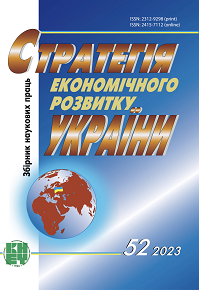ЗАСТОСУВАННЯ ТЕХНОЛОГІЇ ІНТЕРНЕТУ РЕЧЕЙ В АВТОМАТИЗОВАНИХ СИСТЕМАХ УПРАВЛІННЯ РЕСУРСАМИ
DOI:
https://doi.org/10.33111/sedu.2023.52.097.111Ключові слова:
Інтернет речей, ERP-система, управлінські технології, економічна ефективність, конвергенція, управління ресурсами підприємства, автоматизовані системи управління ресурсами, раціональне використання ресурсів, продуктивністьАнотація
У статті узагальнено наукові знання щодо стану та потенціалу розвитку індустрії Інтернету речей (IoT) в Україні та проаналізовано вже реалізовані ініціативи для сприяння її поширенню у сферах охорони здоров’я та управління міським господарством. Метою дослідження є систематизація та аналіз наявної наукової інформації про можливості та потенціал, що розкриває інтеграція ERP-системи та Інтернету речей як конвергентної управлінської технології. За результатами дослідження представлено модель поєднання технологій Інтернету речей та управління ресурсами компаній в ERP-системах; систематизовано переваги, які надає інтеграція ІоТ та ERP-систем; узагальнено проблеми, пов’язані з визначенням економічної ефективності інтеграції ІоТ та ERP-систем на основі аналізу прикладних кейсів у сферах охорони здоров’я та управління міським господарством. У дослідженні було використано методи систематизації, метааналізу і синтезу досліджень зі сфер інформаційних технологій, економіки, менеджменту, права. Додатково використано кейс-аналіз для розуміння практичних аспектів реалізації конвергентних технологій на основі поєднання управлінських та інформаційних технологій.
Посилання
Baranov, O.A. “Internet rechei (IoT): meta zastosuvannia ta pravovi problemy” [“Internet of Things (IoT): Purpose of Application and Legal Problems”]. Information and law 2(25) (2018): 31-44. https://doi.org/10.37750/2616-6798.2018.2(25).270706 [in Ukrainian].
Dmytriv, K. I., Shpak, Yu. N. Doslidzhennia informatsiinykh system v upravlinni pidpryiemstvamy: dosvid ta perspektyvy. [Research of information systems in enterprise management: experience and prospects]. http://ev.fmm.kpi.ua/article/view/108776/103719http://ev.fmm.kpi.ua/article/view/108776/103719 (data 17.04.2023). [in Ukrainian].
Zaiukov, I. V., Voroniuk, D. V., Kuznietsova, V. M., Murashko, A. O., Samchuk, Ya. S. and Samoienko, T. Yu. “Zaprovadzhennia medychnoi informatsiinoi systemy v vinnytskii terytorialnii hromadi”. [“Implementation of the medical information system in Vinnytsia territorial community”]. Naukovi perspektyvy 1(31) (2023): 326-339. https://doi.org/10.52058/2708-7530-2023-1(31)-326-339 [in Ukrainian].
Kyzenko, O. Strategichnij kontroling: koncepciya i sistemna realizaciya na pidpriyemstvi. [Strategic controlling: concept and system implementation at the enterprise]. Kyiv: KNEU, 2019 [in Ukrainian].
Chukut, S. A., Dmytrenko, V. I. “Smart-siti chy elektronne misto: suchasni pidkhody do rozuminnia vprovadzhennia e-uriaduvannia na mistsevomu rivni”. [“Smart city or electronic city: modern approaches to the understanding of the implementation of e-governance at the local level”]. Investytsii: praktyka ta dosvid 13 (2016): 89- 93. [in Ukrainian].
Afzal, B., Umair, M., Shah, G. A., Ahmed, E. “Enabling IoT platforms for social IoT applications: Vision, feature mapping, and challenges”. Future Generation Computer Systems, Vol. 92 (2019): 718-731. https://doi.org/10.1016/j.future.2017.12.002
Amendola, S., Lodato, R., Manzari, S., Occhiuzzi C. and Marrocco, G. “RFID Technology for IoT-Based Personal Healthcare in Smart Spaces”. IEEE Internet of Things Journal, vol. 1, no. 2 (2014): 144-152. https://doi.org/10.1109/JIOT.2014.2313981
Androcec, D., Picek, R. and Mijac, M. “The Ontologically based Model for the Integration of the IoT and Cloud ERP Services”. Proceedings of the 8th International Conference on Cloud Computing and Services Science (CLOSER 2018) (2018): 481-488. https://pdfs.semanticscholar.org/3343/313be08c296ebfd597e46fad27df13d6eda8.pdf (accessed 17.04.2023).
Bahssas, D. M., AlBar, A. M. and Hoque, R. “Enterprise Resource Planning (ERP) Systems: Design, Trends and Deployment”. The International Technology Management Review Vol. 5, Iss. 2 (2015): 72-81. https://www.atlantis-press.com/journals/itmr/24089 (accessed 17.04.2023).
Baker, S. B., Xiang, W. and Atkinson, I. “Internet of Things for Smart Healthcare: Technologies, Challenges, and Opportunities”. IEEE Access vol. 5 (2017): 26521-26544, https://doi.org/10.1109/ACCESS.2017.2775180
Barcelo, M., Correa, A., Llorca, J., Tulino, A. M., Vicario J. L. and Morell, A. “IoT-Cloud Service Optimization in Next Generation Smart Environments”. IEEE Journal on Selected Areas in Communications vol. 34, no. 12 (2016): 4077-4090. https://doi.org/10.1109/JSAC.2016.2621398
Brous, P., Janssen, M. and Herder, P. “The dual effects of the Internet of Things (IoT): A systematic review of the benefits and risks of IoT adoption by organizations”. International Journal of Information Management Vol. 51 (2020). https://doi.org/10.1016/j.ijinfomgt.2019.05.008
IoT value set to accelerate through 2030: Where and how to capture it. McKinsey Report. November 9, 2021. https://www.mckinsey.com/capabilities/mckinsey-digital/our-insights/iotvalue-set-to-accelerate-through-2030-where-and-how-to-capture-it#/ (accessed 17.04.2023).
Marjani, M. et al. “Big IoT Data Analytics: Architecture, Opportunities, and Open Research Challenges”. IEEE Access vol. 5 (2017): 5247-5261. https://doi.org/10.1109/ACCESS.2017.2689040
Matyushenko, I., Pozdniakova, A. Smart Cities in Ukraine — the evolution, state and challenges of smart solutions in the area of governance. https://www.researchgate.net/publication/314036090_Smart_Cities_in_Ukraine_the_evolution_state_and_challenges_of_smart_solutions_in_the_area_of_governance (accessed 17.04.2023).
Mohammadi, M., Al-Fuqaha, A., Sorour, S. and Guizani, M. “Deep Learning for IoT Big Data and Streaming Analytics: A Survey”. IEEE Communications Surveys & Tutorials vol. 20, no. 4 (2018): 2923-2960. https://doi.org/10.1109/COMST.2018.2844341
Nah, F. F-H., ed. Enterprise Resource Planning: Solutions and Management. Hershey, PA: IGI Global, 2002. https://doi.org/10.4018/978-1-930708-36-5
Samie, F., Bauer L. and Henkel, J. “From Cloud Down to Things: An Overview of Machine Learning in Internet of Things”. IEEE Internet of Things Journal vol. 6, no. 3 (2019): 4921-4934. https://doi.org/10.1109/JIOT.2019.2893866
Siddiqui, F., Beley, J., Zeadally, S., Braught, G. “Secure and lightweight communication in heterogeneous IoT environments”. Internet of Things Vol. 14 (2021). https://doi.org/10.1016/j.iot.2019.100093
Siegemund, G., Volker, T. “A Self-Stabilizing Publish/Subscribe Middleware for IoT Applications”. ACM Trans. Cyber-Phys. Syst. 2, 2, Article 12 (April 2018): 1-26. https://doi.org/10.1145/3185509
Snellman, D. Difference in Cloud ERP Systems — A comparison. Degree project in information and communication Technology, Stockholm, Sweden, 2017. https://www.divaportal.org/smash/get/diva2:1119432/FULLTEXT01.pdf (accessed 17.04.2023).
: The year of the Internet of Things. MIT Technology Review. January 4, 2013. https://www.technologyreview.com/2013/01/04/180666/2013-the-year-of-the-internet-of-things/
(accessed 17.04.2023).
##submission.downloads##
Опубліковано
Як цитувати
Номер
Розділ
Ліцензія

Ця робота ліцензується відповідно до Creative Commons Attribution-NonCommercial-NoDerivatives 4.0 International License.


